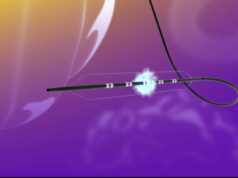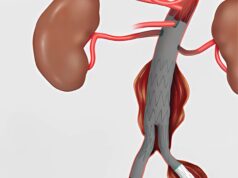
Data from a study seeking to determine the impact of severe calcification and 12-month outcomes of femoropopliteal disease treatment using the Stellarex drug-coated balloon (DCB; Phillips) were presented by Fabrizio Fanelli, Careggi University Hospital, Florence, Italy, at CIRSE (Cardiovascular and Interventional Radiological Society of Europe) 2018 meeting (22–25 September, Lisbon, Portugal). Remarkably similar outcomes were achieved with the device in severely calcified lesions that were amenable to pre-dilation, versus those without severe calcium.
“We know that calcium is the enemy for all endovascular procedures,” noted Fanelli. He acknowledged that although the implications of severe calcification are known—in relation to the occurrence of suboptimal dilation and the ability of calcium to act as a barrier for drugs—the impact of calcium on DCB performance has yet to be fully examined. For instance, previous trials have demonstrated calcium to be a potential barrier to optimal drug absorption; circumferential calcium being the strongest contributor, resulting in the reduction of patency rates.
The authors carried out a prospective study in which patients were pooled from the ILLUMENATE Global (full cohort of the single-arm study; n=371) and ILLUMENATE Pivotal (DCB arm of the randomised trial; n=200). Patency, determined by duplex ultrasound, was assessed at 12 months. Both trials included independent oversight by a Clinical Events Committee and core laboratories analysed angiographic and duplex ultrasound images.
At 12-months, primary patency rates were similar between groups; 82% in the non-severely calcified group compared with 80% in the severely calcified group (log-rank p=0.06). Additional outcomes mirror this similarity; freedom from primary safety events was 93% and the rate of clinically-driven target lesion revascularisation (TLR) was 7% in both cohorts. The rate of 12-month major adverse events was 7.3% and 7.8% (in non-severely and severely calcified lesions, respectively).
Regarding the procedural characteristics, pre-dilatation maximum pressure was higher (9.5 vs. 8.8 atm, p=0.005) and the total DCB inflation time was longer (3.4 vs. 3.9 minutes, p=0.005) in the severely calcified group. Additionally, dissection (>grade C) and provisional stenting rates were found to be similar between groups.
Overall, 556 patients were included in the study, with 242 severely calcified and 314 non-severely calcified lesions. No significant demographic differences were observed in the two groups. However, patients with severely calcified lesions were older and tended to have a higher rate of comorbidities. Severe calcification, prior to contrast injection or digital subtraction angiography, was prospectively defined as “radioopacities noted on both sides of the arterial wall and extending more than one cm of length”.
In light of the findings, Fanelli concluded that similar 12-month outcomes can be achieved with the Stellarex DCB in severely calcified lesions that are amenable to pre-dilatation. The study also confirmed that severe calcium requires longer and stronger inflation, and by doing so, similar stenting rates can be achieved regardless of whether a lesion is severely or non-severely calcified.
Speaking to the CIRSE audience about reasons for the similar patency rates that were observed, Fanelli said: “This can be attributed to the better preparation of the vessel [and] to the characteristics of the balloon itself”.












